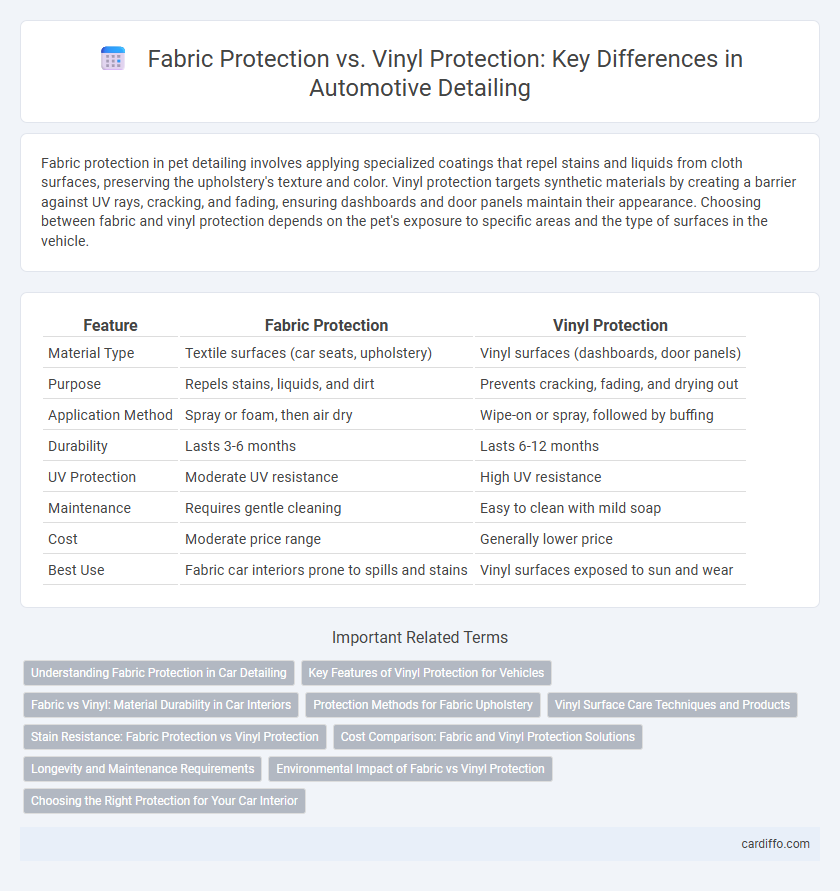Fabric protection in pet detailing involves applying specialized coatings that repel stains and liquids from cloth surfaces, preserving the upholstery's texture and color. Vinyl protection targets synthetic materials by creating a barrier against UV rays, cracking, and fading, ensuring dashboards and door panels maintain their appearance. Choosing between fabric and vinyl protection depends on the pet's exposure to specific areas and the type of surfaces in the vehicle.
Table of Comparison
| Feature | Fabric Protection | Vinyl Protection |
|---|---|---|
| Material Type | Textile surfaces (car seats, upholstery) | Vinyl surfaces (dashboards, door panels) |
| Purpose | Repels stains, liquids, and dirt | Prevents cracking, fading, and drying out |
| Application Method | Spray or foam, then air dry | Wipe-on or spray, followed by buffing |
| Durability | Lasts 3-6 months | Lasts 6-12 months |
| UV Protection | Moderate UV resistance | High UV resistance |
| Maintenance | Requires gentle cleaning | Easy to clean with mild soap |
| Cost | Moderate price range | Generally lower price |
| Best Use | Fabric car interiors prone to spills and stains | Vinyl surfaces exposed to sun and wear |
Understanding Fabric Protection in Car Detailing
Fabric protection in car detailing involves applying a specialized coating that repels liquids, prevents stains, and resists ultraviolet damage on upholstery made from cloth materials. Unlike vinyl protection, which targets synthetic surfaces by maintaining flexibility and preventing cracking, fabric protectors create a breathable barrier that preserves the texture and appearance of textiles. Investing in high-quality fabric protectants enhances durability, extends upholstery lifespan, and simplifies routine cleaning for car interiors.
Key Features of Vinyl Protection for Vehicles
Vinyl protection for vehicles offers superior resistance to UV rays, preventing fading and cracking over time. Its flexible and durable composition makes it ideal for wrapping entire vehicles or accentuating specific areas, providing enhanced scratch and chemical resistance. Unlike fabric protection, vinyl is easier to clean, maintain, and offers customizable design options for both aesthetic appeal and practical defense against environmental elements.
Fabric vs Vinyl: Material Durability in Car Interiors
Fabric protection enhances the lifespan of cloth car seats by resisting stains, fading, and moisture absorption, maintaining comfort and appearance over time. Vinyl protection shields synthetic surfaces from cracking, discoloration, and UV damage, preserving the durability and smooth finish crucial for long-term vehicle aesthetics. Both treatments significantly improve material longevity but cater to distinct maintenance needs based on texture and exposure vulnerabilities.
Protection Methods for Fabric Upholstery
Fabric protection methods typically involve applying a specialized liquid or spray treatment that creates a breathable barrier to repel stains and liquids without altering the fabric's texture or breathability. These protective coatings often utilize advanced nanotechnology to bond with fabric fibers, enhancing resistance to dirt, UV rays, and everyday wear. In contrast, vinyl protection focuses on conditioning and sealing the surface to prevent cracking, fading, and discoloration but is unnecessary for porous fabric upholstery.
Vinyl Surface Care Techniques and Products
Vinyl surface care techniques prioritize gentle cleaning agents and pH-balanced protectants to maintain flexibility and prevent cracking over time. Specialized vinyl conditioners infused with UV inhibitors shield against sun damage, preserving color vibrancy and extending the lifespan of automotive interiors and convertible tops. Consistent application of commercially available vinyl protectants creates a protective barrier that repels dirt and resists fading, ensuring optimal aesthetic and functional durability.
Stain Resistance: Fabric Protection vs Vinyl Protection
Fabric protection treatments create a barrier that enhances stain resistance by repelling liquids and preventing absorption, making cleanup easier on upholstery and carpets. Vinyl protection, designed specifically for synthetic surfaces, forms a durable shield against stains and discoloration caused by spills, UV exposure, and everyday wear. Both protectants use advanced polymers to maintain surface integrity, but fabric protection excels in breathability while vinyl protection offers superior resistance to cracking and fading.
Cost Comparison: Fabric and Vinyl Protection Solutions
Fabric protection treatments typically cost between $100 and $200 per vehicle, offering durable resistance against stains and spills. Vinyl protection solutions range from $80 to $150, providing effective UV shielding and crack prevention for dashboards and door panels. Vinyl tends to be more affordable but may require more frequent reapplication compared to fabric protectants.
Longevity and Maintenance Requirements
Fabric protection treatments typically last between 12 to 18 months, requiring periodic reapplication to maintain water and stain resistance, while vinyl protection can extend up to 3 years with fewer maintenance needs due to its resilient, non-porous surface. Vinyl surfaces benefit from easier cleaning routines, often needing only mild soap and water, whereas fabric demands more frequent gentle cleaning and spot treatments to prevent dirt buildup. Longevity of vinyl protection contributes to cost-effectiveness over time, making it ideal for high-traffic automotive interiors exposed to harsh conditions.
Environmental Impact of Fabric vs Vinyl Protection
Fabric protection treatments typically use biodegradable, water-based chemicals that minimize environmental harm, whereas vinyl protection often involves synthetic polymers and plasticizers that can release volatile organic compounds (VOCs) and persist in ecosystems. The production and disposal of vinyl protectants contribute to microplastic pollution and pose challenges for recycling, unlike many fabric protectants formulated for easier environmental degradation. Choosing fabric protection can reduce the carbon footprint and chemical toxicity associated with automotive and furniture care compared to vinyl alternatives.
Choosing the Right Protection for Your Car Interior
Fabric protection enhances the durability and stain resistance of cloth seats by creating a barrier against spills and dirt, making it ideal for vehicles with cloth interiors. Vinyl protection prevents cracking, fading, and peeling of dashboard, door panels, and vinyl seats by restoring suppleness and blocking UV damage. Selecting the right protection depends on your car's interior material, usage patterns, and exposure to environmental factors to maintain appearance and extend the lifespan of surfaces.
Fabric Protection vs Vinyl Protection Infographic

 cardiffo.com
cardiffo.com